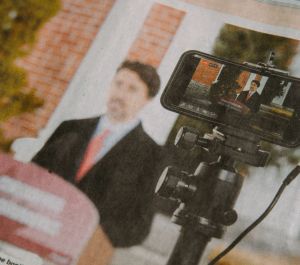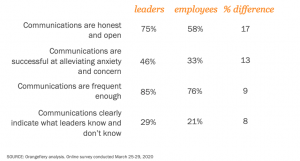Leadership Communications During COVID-19

At the time of this writing, there are more than 2.5 million cases of COVID-19 worldwide and nearly 186,000 deaths. In North America, there are more than 903,000 cases and 50,000 deaths and those numbers are increasing each day.
“There is no precedent in our modern era for the disruption attributable to COVID-19, the disease caused by the novel coronavirus identified in Wuhan, China in December 2019.”
The public health response in North America has been felt throughout and is expected to affect us for many months, if not years. Businesses, government agencies and nonprofits have had to dramatically change policies and practices, often with little notice or preparation. Leaders have been forced to step forward with action and communications as never before in this time of crisis.
Research Studies
A research study conducted (April 2020) by Orangefiery, a communications firm in New York, showed that there was a discrepancy between what leaders of organizations believe they are communicating well, and what employees are expecting.

Based on the research, there were also several items that employees wished their leaders would communicate more often and broadly. Including two-thirds of employee respondents wishing their employer would provide more information about available supports and benefits.
Based on the study, we’ve put together this simple list of ways that you can focus your leadership communications.
1. Transparency – The important thing to remember here is that while people want to know what you know, they also want you to be transparent about what you don’t know. Where can you be clearer on the answers that you don’t know?
2. Supportive – Have you been providing (without prescribing) enough support for your people? Do they know and understand where they can access mental health support, such as EFAP? Do you have any additional programs in place or resources to help them with stress or anxiety?
In addition, as much as you can, make sure you have shared information and support for sick days, personal days, accessing benefits, time billing, etc.
3. Acknowledge the Situation – The number one biggest mistake you can make as a leader is to pretend there’s nothing out of the ordinary going on. Without panicking, it’s important to acknowledge the situation, otherwise, this is called gaslighting and will negatively impact the people you serve.
4. Communicate Frequently – As the situation evolves, so too does the response. Set a schedule for communication and stick to it. Regardless if you plan on addressing your employees once a week, or once a day, make sure you stick to it. This creates trust and alleviates people’s fear of the unknown. Training your spokespeople is just as important as calling upon them for their expertise.
5. Remain Clear & Concise – This should go without saying, but it’s important to be clear and concise with all of your communications. While you want to remain consistent with the frequency of message, don’t just make it an opportunity for you to be ‘front and centre’. Also too, if you’re not the subject matter expert, step aside; the person who is will be able to communicate the message much better than you.
6. Directly Acknowledge Misinformation & Rumors – There will be a lot of misinformation and rumours swirling around, especially when so many of us are ‘working from home’ because it’s basically a giant game of telephone. It’s important that these are directly acknowledged when you hear about them, otherwise, it leaves room for people to assume it’s true. If you’re their trusted source of information (or if that’s your goal), this is a vital exercise in ensuring you keep that status.
The bottom line here, as a leader it’s your responsibility to ensure your people are equipped with the information they need, have a clear understanding of what is expected of them and what they can expect from you, and that you maintain their trust throughout this time and beyond.
A leader’s job in all of this is to confidently be able to say:
“I’ve Got This.”
If you want to chat more about this, book a virtual coffee, we’d love to hear from you!
